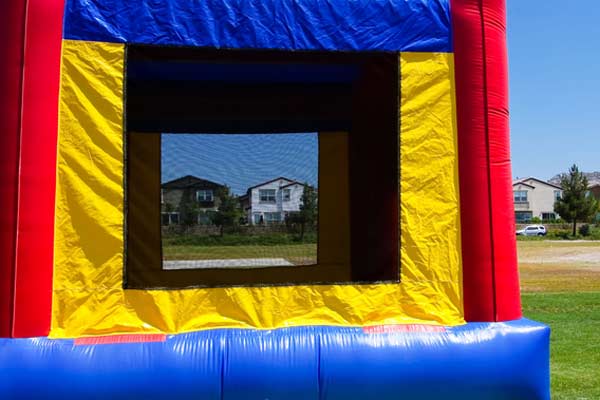
It is given that parents will never cease to worry about the safety of their children, especially in modern society, but we should be able to lower our guard while our young ones are enjoying a harmless activity like bouncing around in an oversized inflatable house…right? A closer examination of this popular pastime, however, tells a different story.
A 2012 study published by the American Academy of Pediatrics demonstrates that injuries to young children resulting from the use of inflatable bounce houses are rising at an “alarming” rate. Records analyzed from the National Electronic Injury Surveillance System database estimated that approximately 64,657 children under age 17 suffered injuries associated with inflatable bouncers from 1990-2010 with a rapidly increasing rate in recent years.1
In 2010, analysts estimated that the rate of bouncer-related injuries requiring medical treatment in the U.S. rose to 31 children per day, or a child every 46 minutes.2 The majority of these injuries occurred to children with an average age of 7 ½ and mainly involved fractures, sprains and strains caused by varying factors.3
Unfortunately, this epidemic is showing no signs of relief. In reality, as you may have heard in the news, a frightening new trend seems to be emerging involving these inflatable bouncers being lifted significant distances off the ground by strong winds. In May of this year, two boys, ages 5 and 6, were hospitalized in New York after being thrown from an inflatable bounce house that was propelled 50 feet off the ground by a strong gust of wind.4
Just two weeks later, a similar incident occurred in Colorado where two children were injured when a bounce house was blown 300 feet from its original location.5 Most recently in October, two toddlers, ages 2 and 3, were seriously injured, one child critically, when a bounce house at a festival in New Hampshire was blown close to 50 feet into the air subsequently crashing down in a neighboring orchard.6 In all of these instances, the inflatable bounce houses were not properly tethered to the ground.
What Can Be Done To Minimize The Risk Of Harm?
Companies that rent out inflatable bounce houses for private functions or public events, as well as the property owners hosting such events, need to enforce safety guidelines to ensure that these inflatable bounce houses are safe for children’s use. This is particularly important since the government has yet to implement any national inspection guidelines or regulations for bounce houses.
First and foremost is the proper training of the individuals who assemble, inspect and secure these inflatable bounce houses prior to their use. Companies must hire qualified individuals and provide adequate training regarding the installation of these bounce houses, particularly the anchoring procedure.
For example, companies need to supply and instruct their workers regarding the use of suitable equipment for anchoring, proper placement of anchors, and comprehensive inspection and testing, whether or not the bounce house is in use. Following the assembly of the bounce house, an operator should remain on site to supervise activities and ensure the bounce house remains secure. Lastly, under certain turbulent weather conditions, workers should restrict the use of the bounce house altogether until the threat passes.
When companies neglect to train adequately their bounce house operators or fail to follow these simple safety precautions, they need to be held accountable for the innocent children who are injured as a result of their carelessness. Companies are responsible for the negligence of their employees while acting in the scope of their employment pursuant to basic agency and respondeat superior principles of law.
Representatives of the farm in New Hampshire where the most recent incident occurred, which is still under investigation, have alleged that the bounce house was not open to the public at the time the children were playing inside, and that the bounce house was only inflated to dry out from the recent rain. These facts, if true, does not automatically relieve the landowner and/or company from responsibility.
For instance, many states including Massachusetts and New Hampshire have attractive nuisance type laws which hold landowners accountable for injuries to children trespassing on their property where an artificial, dangerous condition existed that the landowner knew or should have known would attract children who, because of their age, do not understand the risk.
In summation, the best way to avoid these types of tragedies is for everyone, including parents, to remain vigilant, and for those in control to carefully follow the safety guidelines designed to minimize risk. I believe everyone will agree that companies must take that extra step when it comes to protecting the welfare of our young children.
Learn more about premises liability here.
Sources:
1 Meghan C. Thompson, BA, et. al., “Pediatric Inflatable Bouncer–Related Injuries in the United States, 1990–2010,” Journal of the American Academy of Pediatrics, November 26, 2012; Ryan Jaslow, “Bounce houses injure a U.S. child every 46 minutes, study finds,” CBS News, November 26, 2012
2 Id.
3 Id.
4 “3 kids hurt when wind blows bounce house into air,” MyFox News – Associated Press, May 21, 2014,
5 MyFox New York staff, “Runaway bounce house terrifies parents,” MyFox News, June 15, 2014,
6 “2 Toddlers Injured in Bouncy House Accident,” ABC News via Good Morning America, October 12, 2014
7 Id.
8 See M.G.L. c. 231, § 85Q; Ouellette v. Blanchard, 116 N.H. 552 (1976)
